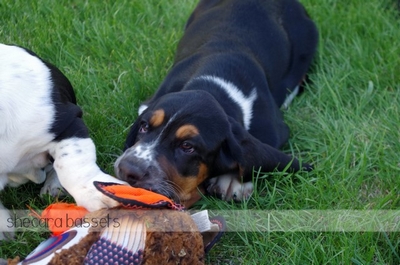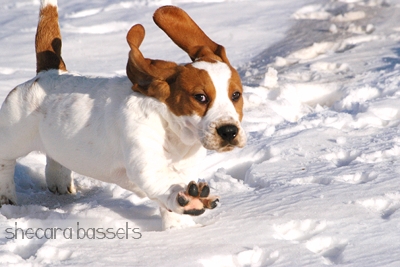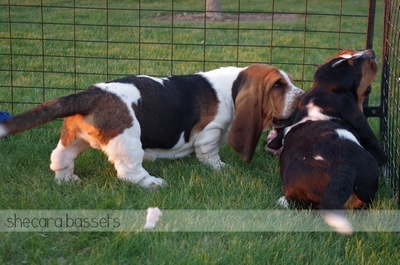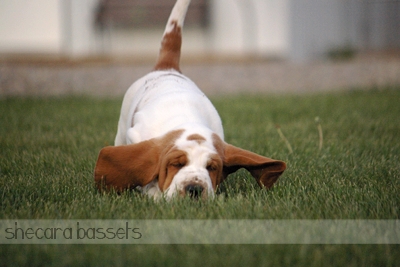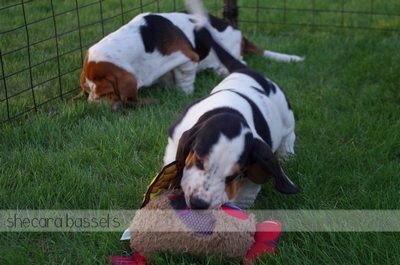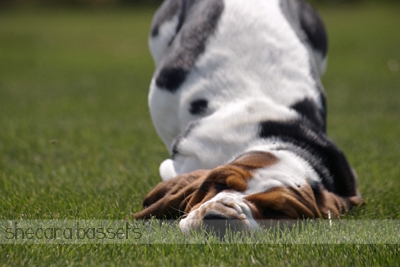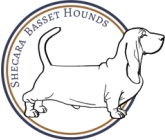Exercise and your Basset Hound Puppy
© Shelley Klok
The Basset Hound is a breed without very high exercise requirements, however there are guidelines to follow to ensure a happy, healthy puppy.
As a large, fast growing breed, there are certain considerations when exercising your Basset Hound. Weighing approximately 450 grams at birth, a Basset Hound will continue to grow until 18-24 months, and multiply his birth weight by 100 to 150 times! Because of the size of the breed, and the rate of growth, this development is delicate, and in addition to proper nutrition, care should be taken to the amount and type of exercise. Especially during the first 6 months, in which the puppy grows very rapidly from a helpless newborn to a gangly “teenager”, improper exercise can lead to bone/joint problems or Panosteitis. Until the growth plates close at 12-18 months, care should be taken to monitor the puppy’s exercise.
Our recommendation for all of our Basset Hound puppies is what we call Continual Free Will Movement. This simply means that the puppy is provided with an area large enough for natural exercise and not given the opportunity to overexert himself. In nature, a young puppy will spend his entire day alternating between napping and activity. He’ll play with toys, run around, flop down, roll over, chew, stretch, wiggle around, etc. This constant mild to moderate activity is what builds muscle tone for proper bone and joint development. Give the puppy a large enough area to play and leave a variety of stimulating toys if you must leave him alone during the day. Take advantage of the outdoors, the sunshine, fresh air and nature to explore is excellent for a growing puppy.
In today’s world, many puppies are confined to a crate overnight, then again during the day while the owner is at work. While I don’t have a problem with the philosophy of crate-training, it is neither natural, nor beneficial for the puppies musculoskeletal development to be crated for that many hours. Even if the crate is big enough for the puppy to stand up, roll over, and stretch, it restricts him from doing any moving around that would naturally build his muscle tone. Continual sitting or laying in the same position is unfavorable to proper growth. In addition, a puppy who has been laying around all day will want to get out and burn off all his extra energy, yet after hours of inactivity his body is not ready for the intense exercise that his mind is telling him he needs. A puppy cannot be trusted to limit on his own exercise once he’s been restricted and has pent up energy waiting to be released, so he must be given the opportunity for continual free will movement!
In addition to providing your puppy with continual free will movement, you will also need to prevent him from overexertion. The following are all things that should be avoided.
• No forced exercise
• No jogging, biking or horseback riding
• No repetitive or high impact exercise
• No wrestling or body slamming
• No jumping off of any furniture or out of vehicles
• No prolonged time spent on any slippery surfaces such as ice, tile, or wet mud
• No hard surfaces such as concrete or asphalt
• Limit access to stairs
Movement is needed, and exercise in moderation is still good for your puppy, so this does not mean to isolate the puppy and cut out all forms of exercise. Short walks, moderate games, playtime and socialization with other dogs is important. Dog parks are great for socialization and play, but not when there’s a lot of running with older/faster dogs and there is a lot of rough play. Never force a puppy, and stop immediately if it seems to bee too much for the puppy. While remembering that a puppy’s rapid development can increase the risk for injury to your Basset Hound, providing him with continual opportunity for movement at his own pace will ensure optimal growth and health to last a lifetime.
